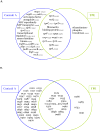Genetic diversity in Treponema pallidum: implications for pathogenesis, evolution and molecular diagnostics of syphilis and yaws
- PMID: 22198325
- PMCID: PMC3786143
- DOI: 10.1016/j.meegid.2011.12.001
Genetic diversity in Treponema pallidum: implications for pathogenesis, evolution and molecular diagnostics of syphilis and yaws
Abstract
Pathogenic uncultivable treponemes, similar to syphilis-causing Treponema pallidum subspecies pallidum, include T. pallidum ssp. pertenue, T. pallidum ssp. endemicum and Treponema carateum, which cause yaws, bejel and pinta, respectively. Genetic analyses of these pathogens revealed striking similarity among these bacteria and also a high degree of similarity to the rabbit pathogen, Treponema paraluiscuniculi, a treponeme not infectious to humans. Genome comparisons between pallidum and non-pallidum treponemes revealed genes with potential involvement in human infectivity, whereas comparisons between pallidum and pertenue treponemes identified genes possibly involved in the high invasivity of syphilis treponemes. Genetic variability within syphilis strains is considered as the basis of syphilis molecular epidemiology with potential to detect more virulent strains, whereas genetic variability within a single strain is related to its ability to elude the immune system of the host. Genome analyses also shed light on treponemal evolution and on chromosomal targets for molecular diagnostics of treponemal infections.
Copyright © 2011 Elsevier B.V. All rights reserved.
Figures


References
-
- Achtman M. Evolution, population structure, and phylogeography of genetically monomorphic bacterial pathogens. Annu Rev Microbiol. 2008;62:53–70. - PubMed
-
- Achtman M, Morelli G, Zhu P, Wirth T, Diehl I, Kusecek B, Vogler AJ, Wagner DM, Allender CJ, Easterday WR, Chenal-Francisque V, Worsham P, Thomson NR, Parkhill J, Lindler LE, Carniel E, Keim P. Microevolution and history of the plague bacillus, Yersinia pestis. Proc Natl Acad Sci U S A. 2004;101:17837–17842. - PMC - PubMed
-
- Antal GM, Lukehart SA, Meheus AZ. The endemic treponematoses. Microbes Infect. 2002;4:83–94. - PubMed
Publication types
MeSH terms
Substances
Grants and funding
LinkOut - more resources
Full Text Sources
Medical

